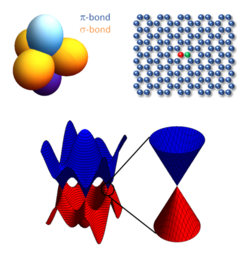
Massless Dirac Carriers in Graphene
Graphene – a single layer of sp2-hybridized carbon atoms arranged in a honeycomb lattice – is one of the few ideally two-dimensional crystals available today. The in-plane σ-bond determines the extraordinary mechanical properties of graphene (graphene is the strongest material that has ever been measured), while the out-of-plane π-bond is responsible for the peculiar electronic properties. Each of the two carbon atoms inside the unit cell contributes a cosine-shaped band to the electronic structure that cross at the corner of the hexagonal Brillouin zone exactly at the Fermi level. In the vicinity of this crossing point (the Dirac point) the band structure follows a linear instead of the conventional parabolic dispersion, and, consequently, charge carriers in graphene behave as if they had no mass. Graphene’s linear band structure bares great potential for applications in optoelectronics, as the relaxation bottleneck imposed by the zero density of states at the Dirac point allows for saturable absorption and even short-lived population inversion. Our goal is to investigate the non-equilibrium dynamics of these massless Dirac carriers and assess the potential of graphene for novel optoelectronic devices.

